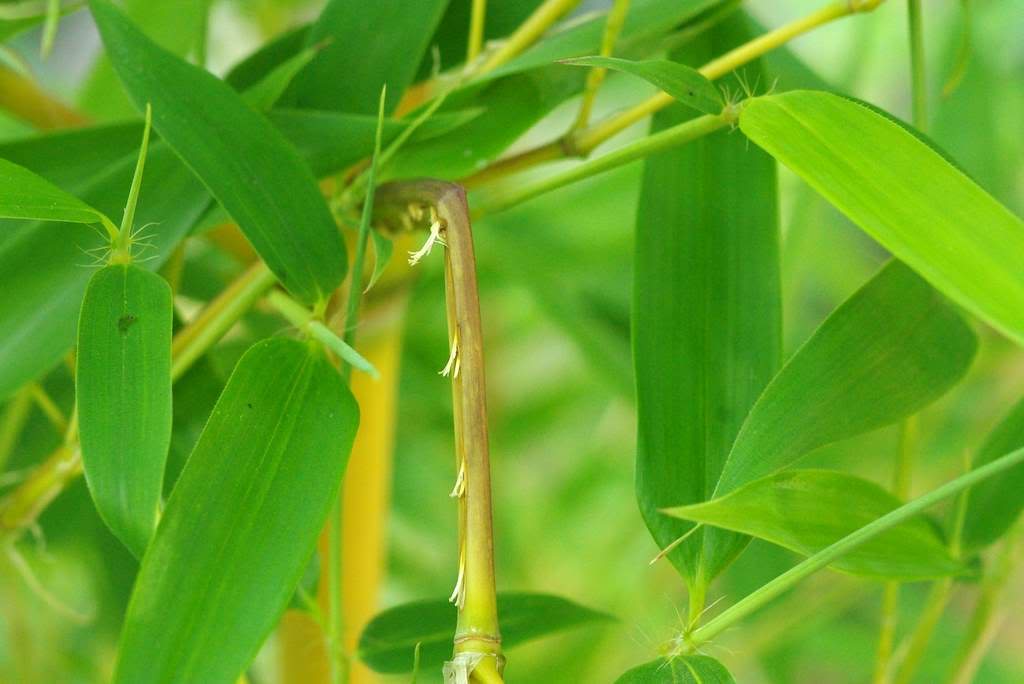More about cicada damage
The other day I posted about the damage that cicadas were causing to small branches of trees and other woody plants. The females make slits in the woody but still soft branches and lay eggs in them. I was somewhat surprised to find that they were using the bamboos in the same way.
Today I have a little more information about this damage to the bamboos, as it's more significant than I thought.
Typically the slits don't cause too much harm to trees, and even if too many females use the same branch for laying and the branch is damaged, it can usually be pruned. Trees and shrubs grow new branches all the time.
Not so with many bamboos. When a bamboo culm (cane) finishes growing (after a month or so) it will never get taller or fatter. Many species don't grow additional branches either. The Phyllostachys genus for example typically produces two branches at each node (ring) on a culm, and that's it forever -- no more branches for that culm. Some species do produce new branches at the nodes each year, but not most of the bamboos I'm growing.
 |
| Brown is a sign this branch is in trouble. |
So when branches on the Phyllostachys bamboos I have are damaged, that's a bit of a problem.
I've noticed that the cicadas appear to be favoring the branches on this year's culms which are softer than the culms from previous years. In fact I haven't yet seen any slits in older branches at all -- they may be out there, but I'm just not finding them. I can see plenty of slits in the new branches though.
It seems that if the slits are made close enough to the base of the branch, that internode (the straight section between the rings) turns brown and dies, meaning the entire branch dies too.
 |
| This branch is a goner. |
It's too early to tell how widespread this is, but I have a feeling I'm going to be losing a lot of bamboo branches this year. I don't expect it to have much impact on the health of the plant, but we'll see how things look in a month or so.
Stupid cicada hordes.
.






They look like they'll be ok. I currently have an atrovaginata shoot snapped from 70mph winds which still has some of the fibers attached, and after a few weeks, the broken part is still green. I plan on leaving it alone until after the shoots are done growing.
Also I don't think they can get every single branch can they?
The only thing that bothers my boos are squirrels and rabbits during shooting season.
If Alan had no suitable trees I'd expect a lot more damage. Good thing the hardened off canes from years past are not being targeted. I wonder if native bamboo is affected? Finally food for thought the US does not having swarming locusts. We killed all of the Rocky Mountain Locusts back in the 1870's.
Steve: so the branches that have turned brown, rotted, and folded over look like they'll be okay? I'm an optimist in the garden, but even I have to think these branches are goners.
I doubt they'd hit every single branch, but they don't need to. If "only" half of the branches die, that's a *lot* of plant material which I may have to prune out.
M: I'd guess that native bamboo (rivercane here) *is* affected, but I know of only one grove in the area and it's not close.
Just to be clear, cicadas are not locusts. Locusts are grasshoppers, which eat plants. Cicadas just suck some of the plant juices. Plus cicadas don't swarm. Interesting info though.
I've never seen cicadas around here so they must be in our area, but, if it is on half the branches, then that might make a dent in the vigor of your bamboos, especially if the larva start growing, and eating the plant material which I didn't think or earlier. Anyways your bamboos look like they're developed enough to come back strong next year.
Luckily the larvae don't do anything to the branches they're hatched in except fall to the ground. They bury themselves in the ground and suck roots for 13 years.